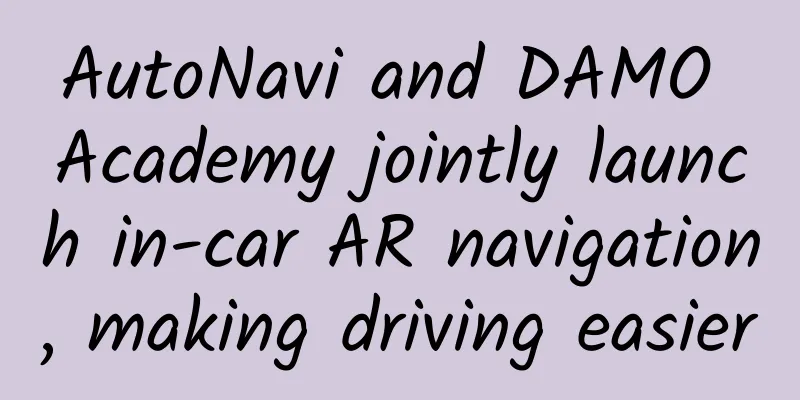AutoNavi and DAMO Academy jointly launch in-car AR navigation, making driving easier

|
On October 17, AutoNavi Maps announced that it would cooperate with DAMO Academy to launch in-vehicle AR navigation. This product uses AutoNavi Maps' traffic big data and lane and navigation engines, as well as the image recognition AI technology jointly developed by the two parties, to provide drivers with a more intuitive real-life navigation function. This product is the first in-vehicle AR navigation that can be used in multiple scenarios in China. The AR navigation launched by AutoNavi and DAMO Academy will first be applied to smart rearview mirrors, and will then be gradually applied to application scenarios such as dashboards and vehicle technology central control. AR (augmented reality) is a new way of interaction. Different from traditional map navigation, in-vehicle AR navigation uses a camera to capture the real scene of the road ahead, and then integrates the car positioning, map navigation information and scene AI recognition, and then generates a virtual navigation guidance model and superimposes it on the real road, thereby creating a navigation screen that is closer to the driver's real vision, making it much easier for users to understand the map. In-car AR navigation can guide users to perform key actions in a variety of driving scenarios, such as where to turn, where to change lanes, etc. Amap's in-vehicle AR navigation can identify passing vehicles, pedestrians, lane lines, traffic light positions and colors, speed limit signs and other surrounding environments, thereby providing drivers with driving safety assistance such as following distance warning, line crossing warning, traffic light monitoring and reminder, front vehicle start reminder, and advance lane change reminder. Due to the complexity of driving scenes, high speeds, and high real-time requirements, the implementation of in-vehicle AR navigation technology is very difficult. In-vehicle AR has very high requirements for navigation accuracy, image recognition accuracy and speed, and AR algorithm sensitivity. Fast and accurate image recognition in a driving environment requires high computing resources. The hardware performance of rearview mirror products and most current vehicle-mounted devices is generally not high. In order to ensure the product experience, Amap and the DAMO Academy Visual Laboratory jointly developed and adopted deep learning technologies such as multi-task learning, model quantization, and transfer learning to improve the model operation speed and optimization effect, thereby achieving real-time detection and recognition of many different scenarios. This will enable Amap's AR navigation technology to add more low-cost devices. As a winner of Toutiao's Qingyun Plan and Baijiahao's Bai+ Plan, the 2019 Baidu Digital Author of the Year, the Baijiahao's Most Popular Author in the Technology Field, the 2019 Sogou Technology and Culture Author, and the 2021 Baijiahao Quarterly Influential Creator, he has won many awards, including the 2013 Sohu Best Industry Media Person, the 2015 China New Media Entrepreneurship Competition Beijing Third Place, the 2015 Guangmang Experience Award, the 2015 China New Media Entrepreneurship Competition Finals Third Place, and the 2018 Baidu Dynamic Annual Powerful Celebrity. |
Recommend
The methodology for launching hot-selling products on Douyin!
In July, a super skin care product quickly became...
An information flow advertising landing page worthy of collection by all industry professionals
We all know that the task of most landing pages i...
In 5 years, 20 years...which workers will be threatened by big AI models?
What impact will large language models (LLMs) lik...
Do you agree that AirPods is Apple’s new chess piece in its Internet of Things layout?
Perhaps the biggest complaint about the new gener...
Taking CCTV and Google as examples, let’s talk about the mechanism design of bidding advertising!
Many people have two extreme views on competitive...
Asian Winter Science Popularization Issue 17丨Deciphering why the body needs to tilt when turning in speed skating?
First instance: Yu Qun Second trial: Suo Yingxing...
What would happen if the entire world lost internet access for a day? Temporary disruptions can actually increase productivity
In 1995, less than 1% of the world's populati...
I learned some tricks of Android
Today I will share with you some of my methods an...
What are the specific customs of the Dragon Raising its Head on February 2? Do you know when to get a haircut? Detailed explanation in one article!
Tomorrow is the second day of the second month of...
6 excellent copywriting strategies to teach you how to write sharp copy!
"One good copy is worth 100 sales experts.&q...
2017 e-commerce marketing report! What are the new ways to play?
The transaction volume on Double 11 this year hit...
Mobile game industry information flow optimization methodology: well-founded material analysis
According to Tencent's Q2 financial report, l...
Learn how to operate the entire business from Li Jiaqi
What is your impression of Li Jiaqi? ——The No. 1 ...
Zhang Xuefeng 2021 College Entrance Examination Volunteer Application Tutoring Course
Many choices and mistakes, How can we fill in the...
2022 Mother's Day Marketing Guide
According to the annual consumer survey report re...









